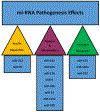Polycystic Ovarian Syndrome Genetics and Epigenetics
- PMID: 33306497
- PMCID: PMC7855879
- DOI: 10.1097/GRF.0000000000000581
Polycystic Ovarian Syndrome Genetics and Epigenetics
Abstract
Polycystic ovarian syndrome and its associated endocrine abnormalities comprise one of the most common metabolic spectrum disorders within the human race. Because of the variance in phenotypic expression among individuals and within family lineages, attention has been turned to genetic and epigenetic changes in which the root cause of the disorder may lie. Further understanding of DNA/histone methylation and microRNA patterns may help to improve the accuracy of diagnosis and lead to future treatment options.
Copyright © 2020 Wolters Kluwer Health, Inc. All rights reserved.
Figures


References
-
- Azziz R, Introduction. Fertility and Sterility, 2016. 106(1): p. 4–5. - PubMed
-
- Trikudanathan S, Polycystic Ovarian Syndrome. Medical Clinics of North America, 2015. 99(1): p. 221–235. - PubMed
-
- Mukherjee S, Pathomechanisms of polycystic ovary syndrome Multidimensional approaches. Frontiers in Bioscience, 2018. 10(3): p. 384–422. - PubMed
-
- Filippou P and Homburg R, Is foetal hyperexposure to androgens a cause of PCOS? Human Reproduction Update, 2017. 23(4): p. 421–432. - PubMed
Publication types
MeSH terms
Substances
Grants and funding
LinkOut - more resources
Full Text Sources
Medical

